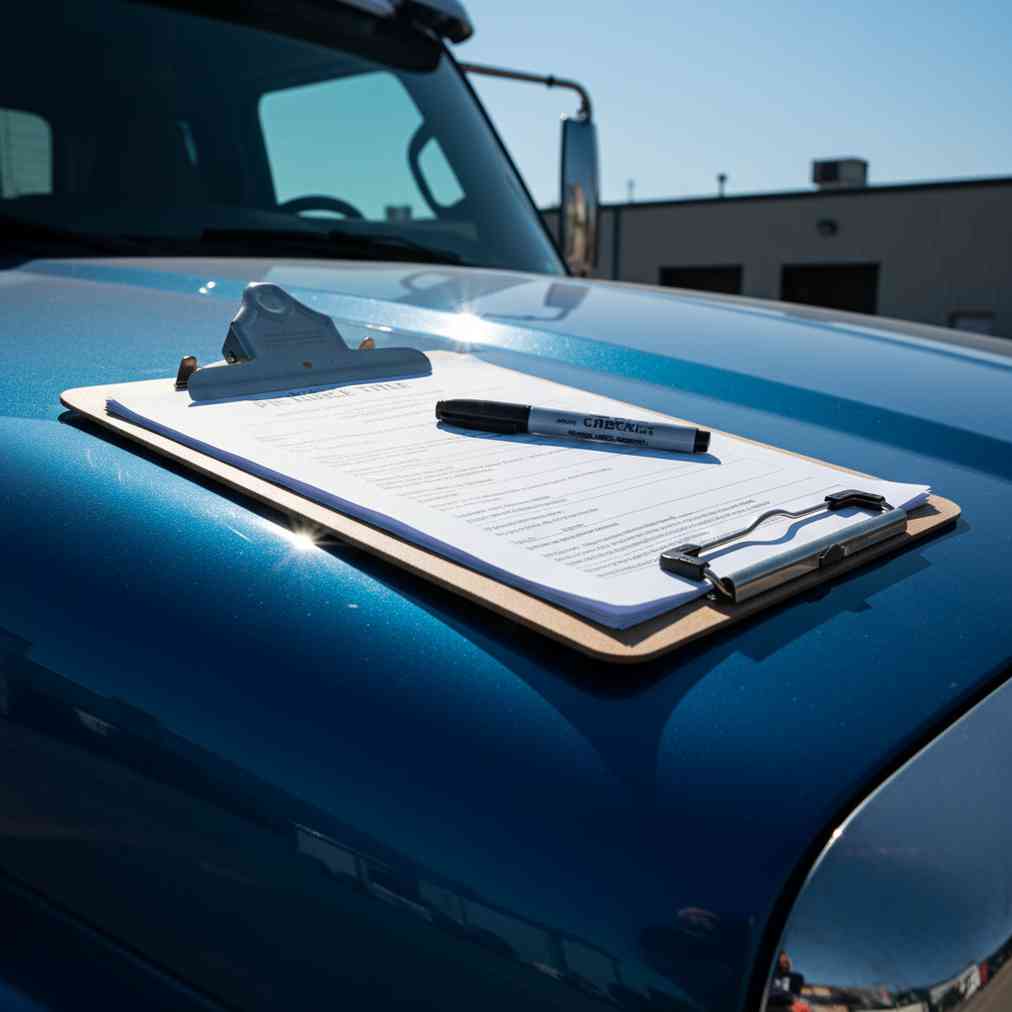Understanding the Junk Car Preparation Process
When companies offer free towing for junk cars, they’re typically purchasing vehicles for their scrap metal value or usable parts. Proper preparation ensures a smooth transaction while protecting sellers from future liability. Understanding what buyers expect can help you maximize your vehicle’s value and streamline the entire process.
The key to successful junk car preparation lies in thorough documentation, complete vehicle cleanup, and understanding the cash for cars process. Whether you’re working with local junkyards or national car buying services, following a systematic approach will save time and prevent complications during pickup.
Essential Pre-Tow Checklist for Sellers
Complete Vehicle Cleanout
The most critical step in preparing your junk car is removing all personal belongings. This process requires more attention than most people realize, as items can hide in unexpected places throughout the vehicle.
- Check all compartments: Glove compartment, center console, door pockets, and trunk
- Look under seats: Remove floor mats and check beneath seats for valuables
- Remove electronics: GPS devices, phone chargers, and aftermarket stereo equipment
- Clear personal documents: Registration papers, insurance cards, and maintenance records
- Check for loose change: Look in cup holders and seat cushions
A thorough cleanout not only protects your personal items but also makes the dismantling process easier for buyers. Many junk car removal services recommend taking photos during this process to document what was removed.
Documentation Requirements
Proper documentation is crucial for a legal transaction. Most reputable buyers require specific paperwork to complete the sale and arrange towing services.
| Required Documents | Purpose | Notes |
|---|---|---|
| Vehicle Title | Proof of ownership | Must be clear of liens |
| Valid Photo ID | Identity verification | Driver’s license or state ID |
| Vehicle Registration | Additional verification | Sometimes required |
| Keys (if available) | Easier towing process | Not always necessary |
If your title is missing, contact your local DMV to obtain a duplicate before scheduling pickup. This preparation step prevents delays and ensures the transaction can be completed smoothly.
Vehicle Access and Safety Preparation
License plate removal is essential before towing. Depending on local regulations, you may need to return plates to the DMV or transfer them to another vehicle. Additionally, ensure the tow truck has clear access to your vehicle by removing any obstacles from the pickup location.
- Remove license plates: Check local requirements for return or transfer
- Clear access path: Move other vehicles and debris
- Check fluid requirements: Some services require oil and gas drainage
- Remove valuable accessories: Custom rims, GPS systems, or premium sound equipment
For vehicles that don’t run, ensure the parking brake is disengaged and the steering wheel isn’t locked. This preparation checklist helps towing professionals load your vehicle efficiently.
Legal and Administrative Steps
Title Transfer Process
Properly signing over your vehicle title is crucial for legal protection. This step officially releases you from liability and prevents future complications if the vehicle is involved in any incidents after the sale.
“Failing to properly transfer title can lead to legal issues down the road. Always complete this step thoroughly and keep documentation of the transfer.”
– Automotive Legal Expert
Post-Sale Administrative Tasks
After completing the sale, several administrative steps protect you from future liability and unnecessary expenses:
- Cancel insurance: Contact your provider after the sale is complete
- Notify the DMV: Submit a Notice of Transfer or Release of Liability
- Keep records: Retain sales receipts and signed title documentation
- Update registration: Remove the vehicle from your registration if required
These steps ensure you won’t be held responsible for tickets, accidents, or other issues involving the vehicle after it leaves your possession. Many junk car guides emphasize the importance of maintaining these records for at least one year.
Understanding Free Pickup Offers
Free towing services are typically offered when the vehicle’s scrap value or usable parts justify the pickup cost. Understanding what buyers look for can help you evaluate offers and choose the best service provider.
What Buyers Evaluate
Professional junk car buyers assess several factors when determining whether to offer free pickup:
| Evaluation Factor | Impact on Offer |
|---|---|
| Vehicle weight and metal content | Higher weight = better scrap value |
| Usable parts condition | Good parts increase overall value |
| Location accessibility | Easy access reduces pickup costs |
| Current scrap metal prices | Market fluctuations affect offers |
| Make, model, and year | Popular vehicles have higher part demand |
When researching options, consider checking with local junkyards near me to compare offers and services. Many facilities provide instant quotes and can arrange same-day pickup for qualifying vehicles.
Choosing Reliable Towing Services
Not all towing services are created equal. Research companies thoroughly before scheduling pickup to ensure a professional experience:
- Check reviews and ratings: Look for consistent positive feedback
- Verify licensing: Ensure the company is properly licensed and insured
- Get written quotes: Avoid verbal agreements that can change
- Understand payment terms: Know when and how you’ll be paid
- Ask about additional fees: Confirm no hidden charges exist
Professional services like those covered in this comprehensive towing guide provide transparent pricing and reliable service. Always get multiple quotes to ensure you’re receiving fair market value for your vehicle.
The Value of Used Auto Parts
Understanding why used auto parts are valuable helps explain the economics behind free junk car pickup offers. Salvage operations and scrap yards are major sources for these parts, which offer significant advantages over new alternatives.
Cost Savings and Availability
Used parts typically cost 50% or more less than new factory parts, making them attractive to budget-conscious consumers and repair shops. This cost advantage is especially significant for older or discontinued vehicles where new parts are scarce or expensive.
- Immediate availability: Large inventory at salvage yards
- OEM quality: Original Equipment Manufacturer parts ensure proper fit
- Tested reliability: Parts have proven road performance
- Wide selection: Multiple options for popular makes and models
Many reputable facilities like those found through quality auto parts junkyards test used parts before selling and may offer limited warranties, increasing buyer confidence in their purchases.
Environmental Benefits
Automotive recycling through used parts significantly reduces environmental impact compared to manufacturing new parts. This sustainable practice conserves resources and minimizes landfill waste while supporting the circular economy.
“Reusing automotive parts prevents millions of tons of materials from entering landfills each year while reducing the energy and resources needed for new part manufacturing.”
– Environmental Protection Agency
Comprehensive Used Parts Inspection Guide
Whether you’re a buyer evaluating used parts or understanding what makes your junk car valuable, knowing proper inspection techniques is essential. This systematic approach ensures quality and value in every transaction.
Pre-Purchase Research and Verification
Before inspecting any used part, verify compatibility with your specific vehicle. The Vehicle Identification Number (VIN) is crucial for matching correct parts, especially for complex mechanical and electrical systems.
| Research Step | Details to Verify | Why It Matters |
|---|---|---|
| VIN Matching | Exact make, model, year | Ensures proper fit and function |
| Part History | Previous use, mileage, accidents | Indicates expected lifespan |
| Seller Reputation | Reviews, warranties, return policy | Protects against poor quality |
| Market Pricing | Compare multiple sources | Ensures fair value |
Visual and Physical Inspection Process
A thorough visual inspection reveals critical information about part condition and reliability. Look for obvious signs of damage, wear, or previous repairs that might affect performance.
- Surface condition: Check for cracks, heavy rust, or corrosion
- Mounting points: Ensure attachment points are straight and undamaged
- Paint and finish: Look for mismatched colors indicating bodywork
- Welds and repairs: Identify previous damage or modifications
- Wear patterns: Assess normal vs. excessive wear
For specialty parts like those covered in guides for buying used turbochargers, additional technical knowledge helps identify specific failure points and quality indicators.
Functional Testing Procedures
When possible, functional testing provides the best indication of part reliability. Different part types require specific testing approaches to verify proper operation.
| Part Category | Testing Method | What to Look For |
|---|---|---|
| Electrical Parts | Multimeter testing | Proper voltage, continuity, resistance |
| Mechanical Parts | Manual operation | Smooth movement, no binding |
| Body Parts | Fit and alignment | Proper gaps, hinge operation |
| Engine Parts | Compression/pressure tests | Within manufacturer specifications |
For online purchases where physical testing isn’t possible, request videos showing the part in operation. Many sellers provide detailed documentation for high-value items like used transmissions to build buyer confidence.
Seals, Gaskets, and Critical Inspection Points
Seal integrity is crucial for many automotive parts, especially those containing fluids or operating under pressure. Damaged seals can lead to leaks and premature failure even if the main part is in good condition.
- Rubber seals: Should be flexible, not brittle or cracked
- Gasket surfaces: Must be clean and undamaged
- O-rings: Check for proper size and condition
- Bearing surfaces: Look for scoring or excessive wear
- Threaded connections: Ensure threads are clean and undamaged
Major Part Evaluation Specifics
Engine and Transmission Assessment
High-value parts like engines and transmissions require specialized evaluation techniques. These parts represent significant investments and potential savings, making thorough inspection essential.
For engines, request compression test results and oil pressure documentation. Visual inspection should focus on obvious leaks, unusual wear patterns, and the condition of external parts. Many sellers provide detailed histories for these high-value items.
Transmission evaluation involves checking fluid condition and color when visible. Dark, burnt-smelling fluid or the presence of metal particles indicates internal damage. Resources like guides for purchasing used Toyota RAV4 transmissions provide model-specific inspection tips.
Body Parts and Structural Elements
Body parts require careful examination for accident damage, rust, and proper alignment. Even minor damage can affect fit and appearance, while structural damage may compromise safety.
- Panel alignment: Check for proper gaps and fit
- Paint condition: Look for fade, scratches, and color matching
- Mounting points: Ensure brackets and clips are intact
- Rust damage: Assess extent and location of corrosion
- Previous repairs: Identify bodywork and welding
Popular body parts like those detailed in crash repair fender guides often provide excellent value when sourced from reputable salvage yards, especially for older vehicles where new parts are expensive.
Tools and Equipment for Part Assessment
Professional part evaluation requires specific tools to accurately assess condition and functionality. Having the right equipment ensures thorough inspection and helps avoid costly mistakes.
Essential Inspection Tools
| Tool | Primary Use | Key Features |
|---|---|---|
| Digital Multimeter | Electrical testing | Voltage, current, resistance measurement |
| Inspection Mirror | Hard-to-see areas | Flexible neck, LED lighting |
| Digital Calipers | Precise measurements | Wear assessment, tolerance checking |
| Flashlight/Torch | General illumination | High-intensity LED preferred |
| Compression Tester | Engine evaluation | Cylinder pressure measurement |
These tools enable thorough evaluation of both common and specialized parts. Many professional mechanics and serious DIY enthusiasts maintain complete tool sets for junkyard visits, ensuring they can properly assess any part they’re considering.
Warranty and Return Policies
Warranty protection provides crucial security when purchasing used parts. Reputable sellers understand the importance of standing behind their products and offer reasonable protection for buyers.
Understanding Warranty Terms
Used part warranties typically differ from new part guarantees, but they still provide valuable protection against defective or misrepresented items. Understanding these terms helps set realistic expectations and protects your investment.
- Warranty period: Usually 30-90 days for used parts
- Coverage scope: Defects vs. normal wear exclusions
- Return conditions: Original packaging, installation requirements
- Labor coverage: Most warranties exclude installation costs
- Proof requirements: Keep receipts and documentation
Quality facilities often provide warranties on tested parts and maintain detailed records of their inventory. This professional approach, similar to services described in professional removal operations, builds trust and ensures customer satisfaction.
Current Market Trends and Developments
The automotive recycling industry continues evolving with new technologies and changing consumer preferences. Understanding these trends helps both buyers and sellers navigate the current market effectively.
Digital Platform Integration
Online platforms increasingly connect buyers with sellers, providing tools for vehicle valuation and local service location. These digital solutions streamline the process of selling junk cars and finding quality used parts.
- Instant valuation tools: Quick estimates based on vehicle data
- Local service mapping: Find nearby junkyards and towing services
- Digital documentation: Electronic title transfers and receipts
- Mobile optimization: Smartphone-friendly interfaces
- Customer reviews: Transparent feedback systems
Environmental Sustainability Focus
Growing environmental awareness drives increased interest in automotive recycling and used part purchases. Consumers increasingly recognize the environmental benefits of extending part lifecycles through reuse.
“The automotive recycling industry prevents millions of tons of waste from entering landfills annually while providing affordable repair options for consumers.”
– Automotive Recyclers Association
This trend supports the continued growth of professional salvage operations and increases the value of properly prepared junk vehicles. Understanding these market forces helps sellers maximize their returns while supporting sustainable practices.
Final Preparation Tips and Best Practices
Successful junk car preparation requires attention to detail and understanding of buyer expectations. Following established best practices ensures smooth transactions and maximum value recovery.
Timing and Scheduling Considerations
Proper timing can significantly impact the value you receive for your junk vehicle. Market conditions, seasonal demand, and local factors all influence pricing and service availability.
- Scrap metal prices: Monitor market fluctuations for optimal timing
- Seasonal demand: Spring and summer often see higher activity
- Local inventory: Popular parts may command premium prices
- Service availability: Schedule during business hours for best service
- Weather conditions: Clear days facilitate easier pickup
Resources like the detailed car scrapping preparation checklist provide additional timing and preparation guidance for maximizing returns on junk vehicles.
Professional Service Selection
Choosing the right service provider ensures a positive experience and fair compensation for your vehicle. Research multiple options and compare services before making your final decision.
Professional operations maintain proper licensing, insurance, and equipment for safe vehicle removal. They also provide transparent pricing and clear documentation for every transaction, protecting both buyers and sellers throughout the process.
By following this comprehensive guide, you’ll be well-prepared to handle the junk car removal process efficiently while maximizing the value of your vehicle. Whether you’re selling for scrap value or usable parts, proper preparation ensures the best possible outcome for your situation.





Leave a Reply
You must be logged in to post a comment.